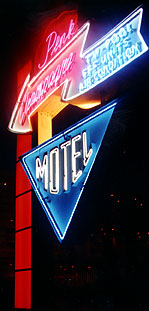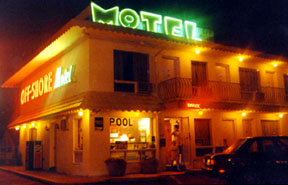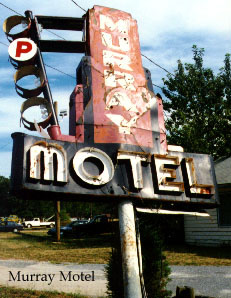Our first trip through the garden state leads us down Highway 40 -- our nation's first federal interstate highway -- towards Atlantic City. Before long, we spot the Pine Motel Tavern ("Rooms for rent at bar"). We meet a guy who owns the vintage Corvette that's parked next to a thick steel railing out front, like a modern hitching post. A.C. units are in varying states of disrepair, some look like they were bought (on sale) a few years ago; others appear to have been run through a washing machine with razor blades for agitators.
We're about thirty miles west of Atlantic City -- at the intersection of 40 and Porchtown Road -- when we find a weathered concrete marker ("Gloucester 1949"). We sidle along a rusty railroad track, lined by telephone poles. The cables have long been cut; they droop lazily in the summer breeze. Before long we start to wonder why there are so many stop signs on this major U.S. highway -- it takes us a while to realize that we've stumbled off course into Vineland ("Policedog. Keep Away"). Our visit is short.
On the outskirts of Atlantic City you'll find the remains of the Murray Motel. As is frequently the case with these relics, it is difficult to discern precisely what's being done to this site. The Murray is clearly in a state of decay -- construction equipment lines the walls, weeds grow in the cracks of the slabs that used to be a parking lot. The hope that someone might renovate this place before the bulldozer makes its final approach is diminished when I note the center of the long side of the L-shaped motel: the roof has collapsed, revealing dark arbors behind. Butterflies flit through the rooms and between the dangling wires.
For the Wood family, our only vision of Atlantic City comes from the Burt Lancaster film of the same name -- decrepit tenements and glitzy casinos separated by overgrown blocks. Pouring with the rest of the traffic through downtown, we strain to recall lyrics of long ago: "On the boardwalk at Atlantic City, life will be peaches and cream." Clearly, that song represents a distant time. (Here's a postcard that might remind you.) Today, A.C. is the kind of town that makes it plain: unless you are here to purchase valet parking and deposit your last few paychecks in one of the several dozen casinos that overshadow the boardwalk, there is little reason to stick around. And if you have any doubt as to who the primary investor in beach front property around here is, doubt no further. The Trump name glows in every corner of this town. Around the edges of A.C., other sorts of predators lay in wait. Jen manages to find a faded beauty though, the Sorrento Motel. While shooting, she learns that the Sands is expanding its parking garage -- so this art deco classic must go.
 As night falls, we make our way south, through Ventner and Ocean City. There, we find the kind of boardwalk for which we drove all this way -- helium balloons, flying kites, hot dog stands, and plenty of salt water taffy. But it is the town of Wildwood that offers a haven for lovers of neon and space-age architecture. The surf pounds the shore just a couple of blocks away from the strip and night brings this town to life. We stop by the Pink Champagne Motel, attracted by its multi-colored glow. Andrew, the owner, is proud of his business -- and its name: "A lot of this stuff is taken from Florida. But I never saw this name. I mean you see the Sea Shell, the Sea Bird, the Sea Gull . . . but I never saw a 'pink champagne.'" Andrew tells me that this is one of the seven original motels built before the crush of new development in the sixties. As such, he figures that this motel deserves to be preserved: "I guess it's about six years ago, I decided I was gonna get a new sign -- take that one down and junk it. I guess I worked a good three months, rendering. Finally I said [to the sign company], 'you know what? We're making life difficult.' I said, 'just duplicate the old sign.' But with the gas they put in it, this sign is a lot brighter than it used to be. This sign is pretty potent."
As night falls, we make our way south, through Ventner and Ocean City. There, we find the kind of boardwalk for which we drove all this way -- helium balloons, flying kites, hot dog stands, and plenty of salt water taffy. But it is the town of Wildwood that offers a haven for lovers of neon and space-age architecture. The surf pounds the shore just a couple of blocks away from the strip and night brings this town to life. We stop by the Pink Champagne Motel, attracted by its multi-colored glow. Andrew, the owner, is proud of his business -- and its name: "A lot of this stuff is taken from Florida. But I never saw this name. I mean you see the Sea Shell, the Sea Bird, the Sea Gull . . . but I never saw a 'pink champagne.'" Andrew tells me that this is one of the seven original motels built before the crush of new development in the sixties. As such, he figures that this motel deserves to be preserved: "I guess it's about six years ago, I decided I was gonna get a new sign -- take that one down and junk it. I guess I worked a good three months, rendering. Finally I said [to the sign company], 'you know what? We're making life difficult.' I said, 'just duplicate the old sign.' But with the gas they put in it, this sign is a lot brighter than it used to be. This sign is pretty potent."
The MarLane Motel invites visitors with plastic globe-lights that cast this site in a murky orange color. The pool glows like lime green jello. Over at the Motel Sea Shell we learn that city leaders are trying to inspire the local tourist industry to adopt a 50s motif up and down the strip. Valentino, a guy who used to own this motel, explains why neon plays a significant role in that appeal: "It's just unique. It has a certain warm glow that attracts people -- and not bugs."
 The Knotts Resort motel draws us off the road again; its green florescent light could attract moths from Ohio. A sign in the office reads, "Vacancy. Couples and families only." Allen is glad to explain why: "When you mix singles and families -- they live in different hours. That place across the street? That guy takes the singles. The police are there at 2 o'clock, 3 o'clock, 4 o'clock, 5 o'clock. They lock 'em up and take 'em away." Stopping at the chrome and glass Wildwood Diner, I reflect on one of the most exhilarating strips of roadside architecture we've seen since Vegas. The problem is that these motels are priced out of reach for the average family driving across country -- especially during the summer. But it's certainly worth a couple of hours up and down the main drags. Along with the signs, motels around here attract customers through an astute use of color and shadow; the facades are lit in all hues of orange, pink, green, and purple. Of course, the plastic palm trees are a nice touch too! It appears that the best way to enjoy a neon tour of Wildwood's wonderful motels is to head south on Atlantic Avenue just after dusk. Most of the signs face that way. But, if your budget is tight, plan to sleep further inland -- perhaps in Rio Grande. We managed to find excellent lodgings at the Off-Shore Motel.
The Knotts Resort motel draws us off the road again; its green florescent light could attract moths from Ohio. A sign in the office reads, "Vacancy. Couples and families only." Allen is glad to explain why: "When you mix singles and families -- they live in different hours. That place across the street? That guy takes the singles. The police are there at 2 o'clock, 3 o'clock, 4 o'clock, 5 o'clock. They lock 'em up and take 'em away." Stopping at the chrome and glass Wildwood Diner, I reflect on one of the most exhilarating strips of roadside architecture we've seen since Vegas. The problem is that these motels are priced out of reach for the average family driving across country -- especially during the summer. But it's certainly worth a couple of hours up and down the main drags. Along with the signs, motels around here attract customers through an astute use of color and shadow; the facades are lit in all hues of orange, pink, green, and purple. Of course, the plastic palm trees are a nice touch too! It appears that the best way to enjoy a neon tour of Wildwood's wonderful motels is to head south on Atlantic Avenue just after dusk. Most of the signs face that way. But, if your budget is tight, plan to sleep further inland -- perhaps in Rio Grande. We managed to find excellent lodgings at the Off-Shore Motel.
Morning in a seaside resort town can be a little disillusioning when you've experienced it first in twilight. You hear the horns and whistles of ocean traffic and avoid the swoops of seagulls. But there's not much else on this foggy morning to remind you of the electricity of last night. Still, we stop by the Tempo Motel -- the one whose doors split diagonally by blue and white. We can't stay long though. The ferry system along the eastern seaboard is pretty handy; but not always convenient. And many more days of travel await.
Return to the lobby.
Last update: April 6, 1999. All photographs copyright © Jenny Wood. Text copyright © Andy Wood.

![[camera icon]](camera.gif) Pine Motel Tavern
Pine Motel Tavern